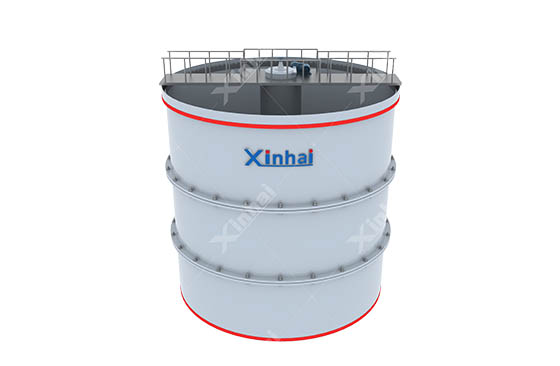

Warm Tip: If you want to know more details about equipment, solutions, etc, please click the button below for free consultation, or leave your requirements!
Multilayer thickener is one of the most common equipment used for pulp washing in gold cyanidation plant. It's the equivalent of several single layer thickeners on top of each other. In order to ensure the normal operation of the multi-layer thickener, it must be strictly operated.

Before starting, it should be "four pipes are unimpeded and no impurities". That is, the ore inlet pipe, ore discharge pipe, washing pipe and overflow pipe are unobstructed, and there is no rubble, cement slag and other sundry in the thickening machine, especially in the mud sealing groove.
Check the transmission parts and oil circuit, and make sure that the oil is sufficient and the circuit is smooth.
Firstly fill all layers except the top layer with barren liquor or pregnant liquid (water available for the first time), and start the motor to operate the thickener.
Feed the pulp and washing water into the thickener at the same time
After a certain thickness of compression layer (mass fraction of 25% or more) is formed in the lowermost layer, in order to prevent the lower discharge pipe from clogging due to too long ore siltation time, a small amount of ore can be discharged intermittently.
With the continuous feeding of slurry, each layer successively forms compressible layer and overflow. At this time, according to the turbidity of the overflow and the amount of return water in each layer, adjust the water level and the amount of water in and out of the wash water distribution box to balance them.
While saving water, adjust the bottom valve to control the mass fraction of emissions to meet technical requirements.
Regularly check the mass fraction of ore discharging to ensure continuous and even water supply and washing.
Observe the turbidity of each layer of overflow water.When the thickener needs to be stopped for overhaul, first stop feeding and continue discharging. Until the mass fraction of the underflow drops to a certain mass fraction (usually less than 25%), the water can be stopped and the machine can be stoped.
If the downtime of the multilayer thickener exceeds 8 hours, the rake should be lifted to prevent it from being held down by the sand.
If the thickener is not operated properly, various failures will occur. The failure of the mudding slot will directly affect the washing effect. There are two main types of common mudding slot failures:
Reason: It is due to sundries or long time accumulation of ore to block the channel, so in the case of not stopping feeding, ore drawing mass fraction becomes smaller and smaller, overflow appears running muddy and motor current increase.
Solution: At this point, you should stop feeding immediately. When the blockage is not serious, it can be cleared by lifting the rabble. When the rake is raised, the discharge gap is enlarged to promote the discharge. When the ore deposits are eliminated, when restoring the rake to its original position, it should be noted that the falling speed of the rake should not be too fast. Generally, one buckle should be dropped every two revolutions.
If raising the rake cannot be effective, then stop the machine immediately. You should suck out the liquid and slurry layer by layer from the upper layer until the clogged mud-seal tank is exposed, then rinse with high pressure water or manually dig out the clogging and clean it up, then restart the machine. You cannot start sucking liquid and slurry from the lower layer, otherwise the upper partition will be collapsed by the upper layer of ore or slurry.
Reason: If it is found that there is no overflow in all layers except the upper layer, the liquid in the washing water distribution box does not flow at this time, the water level difference between the layers disappears, and the entire water level rises close to the upper overflow, which means that the mudding does not form or the mudding was destroyed. The reason may be that the amount of ore discharged is much greater than the amount of ore fed, or the ore feeding is interrupted for too long and the ore continues to be discharged, which makes the compression layer in the thickener thin and even disappear.
Solution: It should be adjusted in time when the mud seal is found to be destroyed. While minimizing the amount of ore discharge, ensure uniform and continuous ore feeding, appropriately reduce the speed of the rake or lower the rake to reduce the discharge gap, so that the thickener gradually resumes normal operation.
The above introduced the operation process, common problems and solutions of multilayer thickener. In actual production, the work should be carried out in strict accordance with the operating specifications to ensure the normal working efficiency of the multilayer thickener.
If you have other questions about the above content, or want to buy a multi-layer thickener, you can consult online customer service or submit a message, we will contact you as soon as possible.
1How To Operate Multilayer Thickener And How To Deal With Problems?
 0
0
 2359
2359
23 Commonly Used Zinc Powder Feeders In Cyanidation Plant
 0
0
 2702
2702


What Are the Differences Between CIP and CIL?
 11000
11000
 0
0